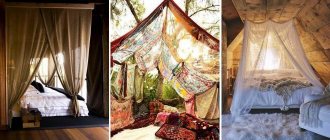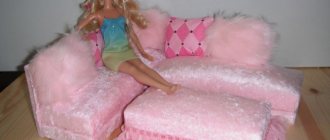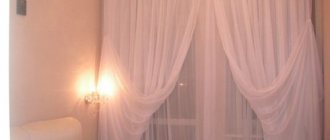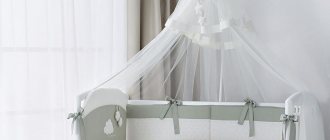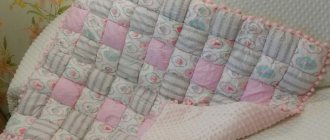With the advent of children, the house becomes especially cozy and warm. And the most cheerful and bright room in the house is the children's room. But sometimes, when entering a child’s room, it seems that something is missing. And most likely the canopy is missing. This accessory will not only decorate the crib, but will also protect the baby from the bright sun during naps.
In fact, sewing a canopy with your own hands is not so difficult; it is enough to have minimal sewing skills on a sewing machine or by hand. If you have a machine, the process will go faster than when working with a hand seam.
Is there any benefit to a canopy?
So, what is a canopy for? First of all, its benefit lies in protecting the baby from the rays of the bright sun entering the window, drafts and insects. If there are cats or dogs in the home where there is a newborn, a canopy over the crib will help prevent hair from getting into the baby's crib.
Calling the canopy a “dust collector”, we are not far from the truth. It really collects dust, preventing it from settling on the bedding. And since the curtains are sewn from light, thin fabrics, it is not difficult to wash it.
In addition, such a “barrier” from the outside world gives the child a feeling of security and emotional comfort.
How to hang a canopy on a crib? There are 3 options: a canopy assembled on a holder that is fixed to the ceiling, a mount at the head of the bed, and a design on a stand.
DIY crib canopy holder
The basis of the design is the holder. In ready-made kits it is attached to the canopy, but if you are sewing a canopy for your baby’s crib yourself, you can make it yourself.
An excellent material for making a holder is thick wire. It is rolled into a circle or oval shape and then secured to the ceiling or at the head of the crib using a hook.
If we are talking about a structure on a stand, you will need to build it too. To do this, you can use a wooden stick, as well as a metal or plastic tube. In this case, the holder will be attached to the stand using a clamp.
Everything you need for work
The canopy is considered not only a beautiful accessory for the bed, first of all it performs a practical function. Such a device can protect the bed from prying eyes, and also add special comfort to the bedroom. To make a canopy yourself, you must first decide on its design.
Before you start work, you need to prepare all materials and tools. Below is a list of materials needed to create a classic canopy:
- textiles - it is better to choose a not very heavy, transparent fabric. The best choice is organza or veil. For a children's bed, you can purchase silk, linen or chintz;
- frame materials. Hollow metal pipes are often used for this. Previously, the base for the canopy was made of wood; today this design is less popular;
- fasteners - you should use only high-quality steel bolts, which will allow the structure to support the weight of the fabric and maintain stability above the bed.
Tools that will be useful are a drill, a screwdriver, screwdrivers, a tape measure, a simple pencil, and a grinder for working with metal. To sew the cape itself you will need a sewing machine, threads, needles, and frill.
How to hang a canopy over a crib to the ceiling
This option is suitable for those who do not regularly rearrange the furniture in the room. Otherwise, constantly moving the structure from place to place will cause you a lot of trouble.
In order to attach the canopy to the ceiling, you will need to do the following:
- Mark a place above the crib where the holder will be located.
- Attach the canopy base to the ceiling with self-tapping screws.
- Assemble the canopy onto the holder (different designs provide different mounting options: Velcro, tape, etc.).
After this, all you have to do is straighten the fabric, evenly distributing the folds. If you did everything correctly when assembling your canopy, you will have a fabric “house” above the crib.
How to attach a canopy holder to a baby crib: frame with fastenings
In this case, the frame for the canopy will be attached to the crib using the accessories included with the canopy. You can place the structure at the head of the crib or on its back wall. In the first case, only half of the crib will be covered with fabric, in the second, you can completely cover the baby’s sleeping place.
How to install such a device? To assemble the canopy on the frame, you need to follow this sequence:
- Connect the frame parts.
- Install fasteners in accordance with the instructions.
- Adjust the height of the structure.
- Secure the frame using fasteners in the chosen location: at the head of the bed or on the side of the crib.
- Fasten and straighten the fabric.
The assembly process will not take much time, and as a result, your baby will feel comfortable.
Second option
A simple model can be sewn quickly and easily with your own hands. This master class presents photos with which you can easily cope with this task. The size of our product will depend on the length of the retainer, crib, canopy and others.
We need to prepare for sewing a canopy:
- material, the width of which should be at least one and a half meters, and the length - from 2 to 3 meters;
- various decorations - frills, lace, butterflies;
- ribbon for processing edges, preferably at least 5 meters;
- thick ribbon to form the top, which should be 3.5 meters long and 6 centimeters wide.
Let's move on to a step-by-step description of sewing a canopy.
We need to cut out two parts of the product - right and left. There is no need to use any complex patterns. Below is a diagram for those who are just starting to sew:
This is the most common pattern with which you can cut out a simple one. The corners on the pattern are rounded, but you don’t have to do this
It is important that the two parts are mirror identical
When we cut out the parts we need from the fabric, then we need to process the edges with ribbons - ribbons. And if you don’t want to trim the edges, you can simply hem them. Now we need to connect the two parts. Afterwards, we sew on frill, lace or other ribbons. Our product is ready, all that remains is to attach it. To do this, we need to retreat 4 centimeters from the top of our curtain on both sides. Now you can pass the holder inside.
Based on the proposed sewing options, we can confidently say that any beginner can cope with such work.
How to assemble a canopy for a crib: canopy on a stand
Assembling the structure on a stand is not as difficult as it might seem at first glance. This is something like a tripod, which consists of the following elements:
- the main part that provides stability (this can be a curved tube or a solid platform);
- straight tubes that connect to each other (most designs provide the ability to adjust the height of the tripod);
- the supporting part of the upper part of the tripod (in the form of a tube with a bend);
- the upper part is in the form of an oval or circle (the fabric will be collected on it).
In order to install the frame on the stand, you need to make a minimum of effort. Simply connect all the parts to each other: insert a rod consisting of 2 parts into the hole on the platform that serves as the base, then attach the supporting part and an oval or round holder. Then fix the height of the structure and hang the canopy, straightening the folds.
This option has a number of advantages compared to attaching the canopy to the ceiling or to the headboard. The advantages of the tripod design include:
- if necessary, it can be easily moved to another place; simply rearrange it;
- it is possible to change the height of the bar;
- over time, when the child gets older, the former canopy can be “converted” into a playhouse or tent.
The only drawback is the light weight of the structure, and if there are cats or dogs in the house, they can knock over the frame by touching it or pulling the light fabric with their claws. For this reason, pet lovers are better off choosing other options.
Construction steps
Step 1. How to sew a canopy for a canopy at home.
For the base, which will serve as a cape, you need to use fabric 1.5 m wide. In order not to make a mistake with the length, you need to measure the distance from the place where the canopy is attached to the lower corner of the cradle. The optimal solution would be if the material reaches the flooring.
The fabric needs to be sewn along the edges. From the side of the base, make a fold of the fabric, stitch it, stepping back from the edge of the fabric by 2 cm. The size of the gap should be adjusted to the frame, which will allow you to stitch the product correctly so that it looks neat. At the end, you can optionally add various details for the original design of the canopy.
Step 2. How to make a frame yourself
It’s good when you have a ready-made frame in stock, but if you don’t have it, you can make it yourself at home.
There are 2 ways to make a replacement holder:
The first option for making the frame on your own
You need to take a metal rod . It is necessary to give it the shape of a semicircle or the shape of the letter “P”. Thus, the canopy is fixed on a rod, which, in turn, is installed above the crib.
The second way to make a frame on your own
This method is more affordable and the frame will look neater. To make the frame, you only need one part - an embroidery hoop. Almost every craftswoman has them in stock, and even if not, you can purchase them at a very low price. The larger the diameter, the more beautiful the canopy will be.
Step-by-step recommendations for making canopy mounts on your own:
- Separate the hoop rings from each other.
- Place a ready-made canopy on the larger circle.
- A circle of smaller diameter, cross-tied with a rope, which will make the device more durable.
- The final step is to reassemble the hoop and screw it very tightly.
Once you have completed all the steps above, you should attach the canopy ring to the holder. It is recommended to attach the device in the traditional way on the side of the cradle, or use a bracket as a holder, attach it to the ceiling, and hang the frame on it.
How to hang a canopy on a crib
When the structure holding the fabric is assembled and the installation is completed, all that remains is to hang the canopy over the crib. How to dress and secure the fabric?
If you purchased a ready-made canopy, there will be no problems: just follow the attached instructions. But in cases where you sewed the canopy yourself, the canopy is attached in different ways, you can choose one of the methods:
- sew ribbons to the upper edge of the canopy, which are tied to an oval or round holder;
- use the Velcro fastening method sewn to the canopy;
- Throw the fabric over the frame, gathering it under the structure using an elastic band or tape.
When using the canopy, do not forget about timely washing of the fabric, otherwise this device will not be useful, since it will collect a huge amount of dust in the folds.
Choice of fabric and tailoring features
The main thing in choosing fabric is safety for the child.
The choice of fabric depends entirely on the preferences of the parents. It is important to consider the following factors:
- what density will the curtains be;
- what the final version looks like;
- how much material is required.
It is advisable to use lightweight and breathable fabrics in light colors that are aesthetically attractive. The material should not be saturated with chemicals - this can negatively affect the child’s health. When determining the size, you need to take into account the fact that the cover covers the entire perimeter of the crib. If there is too much fabric, the baby may get confused. It is also important that it be practical, easy to wash multiple times and dry quickly.
The following options are suitable:
- Linen - if the room is on the sunny side, then a thick curtain will protect well from light. But we must take into account that it does not allow air to pass through well.
- Tulle will add lightness to the room, but during the cold season it can only serve as an addition.
- Velvet is suitable as a cover for a canopy to highlight the decoration, but it gets very dusty.
In addition, you can use various fabrics made of synthetic fiber or mesh, translucent. Additional alternative: organza, voile, chiffon, cotton, chintz, cambric, etc. You should not use silk (it can be an allergen), wool and other fleecy fabrics (they are highly electrified).
